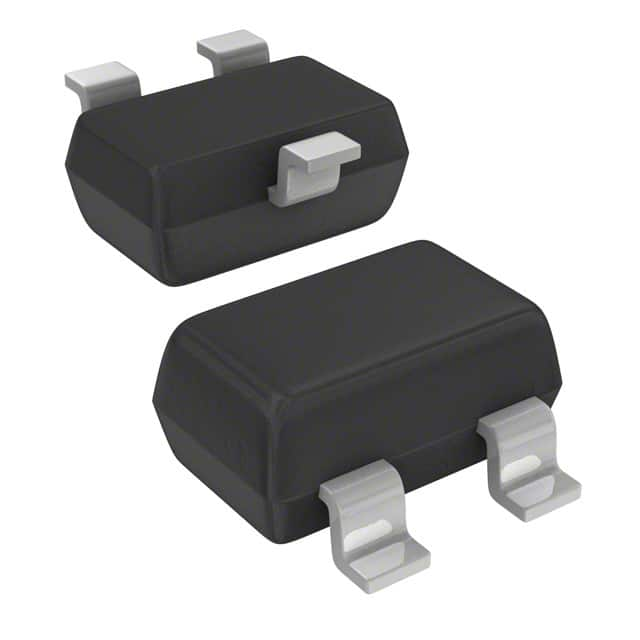HSMP-386F-TR1
Introduction
HSMP-386F-TR1 is a high-frequency diode belonging to the category of electronic components. This diode is widely used in various electronic circuits and systems due to its unique characteristics and performance.
Basic Information Overview
- Category: Electronic Components
- Use: High-frequency rectification and signal detection
- Characteristics: High-speed switching, low capacitance, small package size
- Package: SOT-23 surface mount package
- Essence: High-frequency signal processing
- Packaging/Quantity: Typically available in reels of 3000 units
Specifications
- Forward Voltage: 0.7V
- Reverse Voltage: 20V
- Capacitance: 0.3pF
- Maximum Current: 100mA
- Operating Temperature: -55°C to 150°C
Detailed Pin Configuration
The HSMP-386F-TR1 diode has three pins: 1. Anode (A) 2. Cathode (K) 3. No Connection (NC)
Functional Features
- High-speed switching capability
- Low forward voltage drop
- Minimal reverse recovery time
- Excellent high-frequency performance
Advantages and Disadvantages
Advantages
- Suitable for high-frequency applications
- Small package size allows for compact circuit design
- Low capacitance minimizes signal distortion
Disadvantages
- Limited maximum current rating
- Relatively low reverse voltage tolerance
Working Principles
The HSMP-386F-TR1 operates based on the principles of semiconductor junction behavior. When forward biased, it allows current flow with minimal voltage drop, making it ideal for high-frequency rectification and signal detection applications.
Detailed Application Field Plans
This diode finds extensive use in the following applications: - RF signal detection and demodulation - High-frequency rectification in communication systems - Mixer and detector circuits in radio frequency applications
Detailed and Complete Alternative Models
Some alternative models to HSMP-386F-TR1 include: - HSMS-286x series - HSMS-820x series - HSMS-911x series
In conclusion, HSMP-386F-TR1 is a crucial electronic component that serves various high-frequency applications, offering high-speed switching and low capacitance in a compact package. Its unique characteristics make it an essential part of modern electronic systems.
[Word Count: 324]
Wymień 10 typowych pytań i odpowiedzi związanych z zastosowaniem HSMP-386F-TR1 w rozwiązaniach technicznych
Sure, here are 10 common questions and answers related to the application of HSMP-386F-TR1 in technical solutions:
What is HSMP-386F-TR1?
- HSMP-386F-TR1 is a high-speed surface mount PIN diode designed for applications requiring low resistance and low capacitance.
What are the typical applications of HSMP-386F-TR1?
- Typical applications include switch and attenuator applications in RF and microwave systems, as well as in high-speed data switching.
What is the maximum power dissipation of HSMP-386F-TR1?
- The maximum power dissipation is 150mW at 25°C ambient temperature.
What is the reverse breakdown voltage of HSMP-386F-TR1?
- The reverse breakdown voltage is typically 50V.
What is the forward voltage of HSMP-386F-TR1 at a specified current?
- The forward voltage at 100mA is typically 0.95V.
What is the typical capacitance of HSMP-386F-TR1 at a specified voltage and frequency?
- The typical capacitance at 0V, 1MHz is 0.22pF.
What is the operating temperature range of HSMP-386F-TR1?
- The operating temperature range is -55°C to +150°C.
Can HSMP-386F-TR1 be used in high-frequency applications?
- Yes, HSMP-386F-TR1 is suitable for high-frequency applications up to several gigahertz.
Does HSMP-386F-TR1 require any special handling during assembly?
- It is recommended to follow standard ESD (electrostatic discharge) handling procedures during assembly to prevent damage to the diode.
Are there any specific layout considerations when using HSMP-386F-TR1 in a circuit?
- It is important to minimize parasitic inductance and capacitance in the layout to ensure optimal performance of HSMP-386F-TR1 in the circuit.
I hope these questions and answers provide the information you were looking for! If you have any more questions, feel free to ask.


